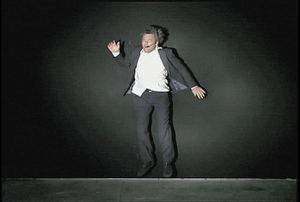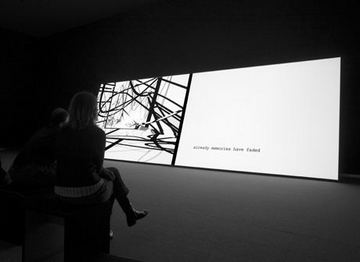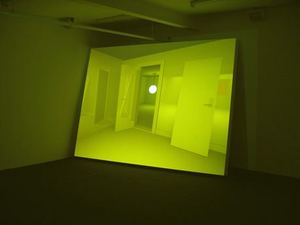The two poles of contemporary video art could be represented by South Africa’s William Kentridge (previous post) and Norway’s Ann Lislegaard. He’s the raw to her cooked, the coarse to her silky, the earth to her alien tread.
Since both have solo shows at the Henry (his upstairs, hers down), a little compare and contrast is inevitable, but each deserves to be seen in his/her own light.
Henry, take a bow. These shows make sense in relation to each other. The idea behind their presentation is clear – a survey from mountain top to mountain top. The third ingredient of good programming – an acknowledgment of where the Henry itself is located in the world – is missing, however. What are the NW video affinities?
At the very least, a small Gary Hill show would have been a fine thing. Seattle’s Hill stands between Kentridge and Lislegaard, leaning toward her. More accurately, she leans toward him. She matches his cool clear-sightedness, his intellectual rigor. Unlike hers, his work (like Kentridge’s) is rooted in body awareness and the tragedy of its struggles on the road to death.
Lislegaard shares Hill’s interest in language as a manifestation of
sculptural presence, but the meaning he derives is visceral, while hers
is as remote as the North Star.
(Gary Hill, still photo from Wall Piece, video. His insights along with a portion of the video here.)
Click images to enlarge.
 At the Henry, organized by senior curator Elizabeth Brown, are a trio of Lislegaard’s digital-animation installations inspired by science fiction. In her antiseptic world, life mutates without birth pangs from solids to liquids, spare interiors to false-front forests and texts that clarify before they blur and run.
At the Henry, organized by senior curator Elizabeth Brown, are a trio of Lislegaard’s digital-animation installations inspired by science fiction. In her antiseptic world, life mutates without birth pangs from solids to liquids, spare interiors to false-front forests and texts that clarify before they blur and run.
(Lislegaard, from Crystal World (after J.G. Ballard)
 The chill from her work is real, and so is its power. Black cut against white softens to gray and turns into water. Her view of physics argues against the idea of personal volition.
The chill from her work is real, and so is its power. Black cut against white softens to gray and turns into water. Her view of physics argues against the idea of personal volition.
Lislegaard, Bellona (after Samuel R. Delany)
 It’s a theory of everything that leaves everything out. In her
It’s a theory of everything that leaves everything out. In her
gravitational flow, we are dead stars visible on time borrowed from the
past. She’s interested in the world without the world, what impressions it leaves on the flexible coils of matter.
Note: I was thrilled to see two small exhibits honoring NW artists who died this year, Richard C. Elliott (my obit here) and Doris Totten Chase (my obit here). From no other art museum is there any indication that they lived and died here, and both mattered greatly. Bloom where you’re planted, people. You are not curating on Mars. (Thank you, Henry Gallery associate curator Sara Krajewski.)



Before I came on board at the Henry, I had the opportunity to write about Doris Chase’s video work on the occasion of a small show at Bellevue Art Museum. (Back in the day of “Art” not “Arts”…) She really was a pioneering figure and I was so happy to have the chance to meet her then. It’s difficult to make these types of memorial shows — in order to be timely, we make due. But there is a lot of work to be seen and reconsidered for both of them.
Sara K.
Both well-thought out. Not just a couple of pieces on the wall, but key to understanding who they were and what they made.